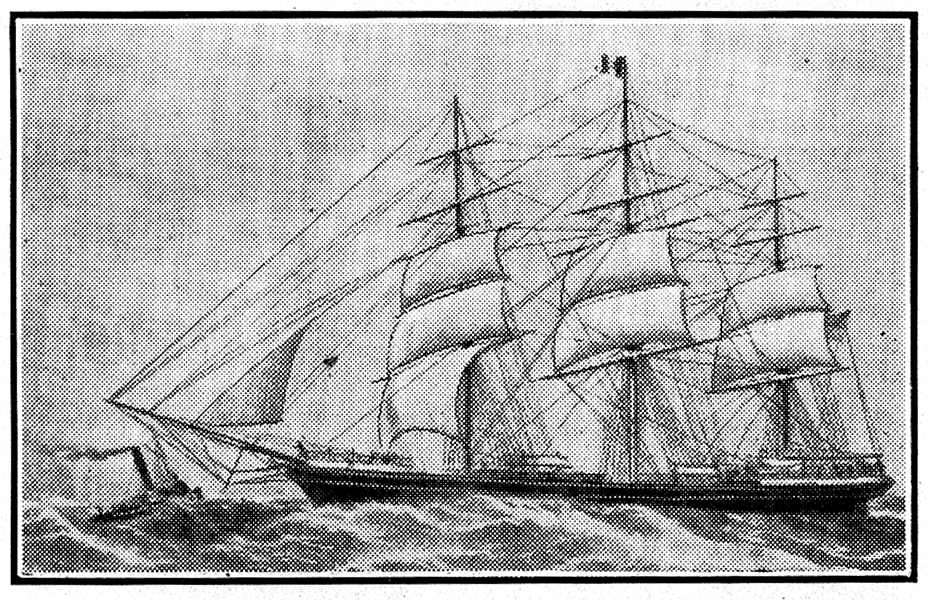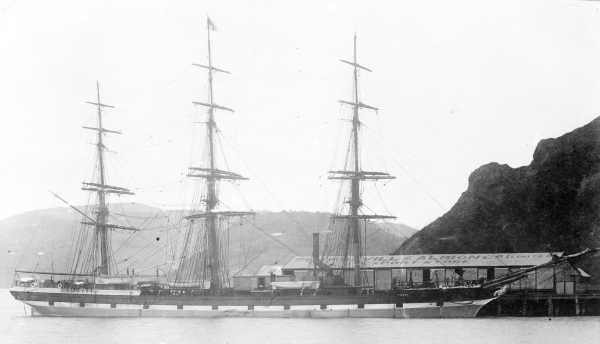 Chris Korte's New Zealand Genealogy Project
Chris Korte's New Zealand Genealogy Project
1876 Voyage to NZ by sailing ship Timaru
About page
This page provides some details of the sailing ship Timaru and the 1876 voyage to New Zealand from Glasgow, Scotland. For the voyage there were 349 immigrants and six saloon passengers. John HEAVEY, his wife Mary CULLEN and their seven children were immigrants on the Timaru to New Zealand in 1876. John, a farm labourer, was 39 years of age, Mary 38 and the clidren 3-18 according to the passenger list. The family's passage was paid for by the New Zealand Government, a total of £106 11s 6p.
If you can provide additional information, or corrections, please contact (see Info menu).
The Timaru
The sailing ship "Timaru" was built in 1874 by Scott & Co., Greenock, Scotland for Patrick Henderson's Albion Line. She was an iron sailing ship with three masts, 1,306 tons, 73 m (239 ft) long, 11 m (36 ft) breadth, and had a depth of 6 m (21 ft). The Timaru was built and fitted up expressly for carrying passengers to New Zealand, frequently landing 400-500 passengers at Dunedin from Scotland. The Timaru was launched on 9 Dec 1874. Between 1875 and 1896 she made 15 voyages to New Zealand, 11 to Port Chalmers, Dunedin. The voyage of the Timaru to New Zealand took 74-106 days depending on weather conditions.
The Timaru was owned/operated by the Albion Line from 1875, Shaw Savill & Albion Co. from 1883, South African Supply & Cold Storage Co, London from 1899 and E. B. Aaby of Drammen, Norway fromn 1906. She was wrecked near Fjaltring, W Jutland, on a voyage from Flushing to Christiania, with the loss of 16 lives and a valuable cargo on 22 Feb 1907.

The "Timaru" under the Albion Line.From White Wings 50 years of Sail in New Zealand 1840-1900.

The "Timaru" at Port Chalmers under Shaw Savill & Albion Co.From http://shawsavillships.org
1876 Voyage to NZ

ARRIVAL OF THE TIMARU.
The announcement of the arrival of the Albion Company's ship Timaru at the Heads was made early yesterday forenoon, with the signal - all well on board. She was just due, for in the case of a vessel of her size, power, and sailing qualities, and also being in what may be termed "immigrants' trim," that is, lightly burdened with cargo, 85 days from port to port is a good average passage. The Timaru was brought up harbour by Geelong, and moored pro tem. off the Railway Pier, this proceeding demonstrating that the immigrants on board had arrived in good health. The official inspection of the ship having been made, the Press reporters and Cartain Logan, the Company's marine Superintendent, boarded her and, the usual amenities exchanged with the Captain. The pressmen were conducted through the immigrants' quarters by the Surgeon-Superintendent, Dr Crauford, an old acquaintance, who visited the Port last year in the same capacity in the Nelson. The inspection on the part of the Press was merely a formal affair, for there was nothing to be noted but the extreme of cleanliness and good order, with healthy; respectable, contented looking men, women, and children thronging the ship above and below deck. The single men's and single women's quarters, forwards and aft, were fitted up as comfortably as could be desired, with lots of space and ventilation, and light ad libitum. The married people amidships were, of course, a little more crowded, but on the whole were comfortable and clean. In reply to our interrogatories, the immigrants one and all spoke in downright terms of laudation relative to the passage and their entertainment on board. A kind and considerate doctor and captain was the character bestowed upon the two superiors of the ship. And the good feeling was reciprocal, for both captain and doctor spoke well of those they had in charge, and recommended them as a superior class of people. The matron, Miss Hamilton, had a good word for her particular charges, who are mostly of the farm and domestic servant class. Healthy, robust, and not forward, was our estimate o£ the bevy of lasses who held possession of the poop deck, and gazed curiously and longingly at the pleasant shore of their adopted land. The young men appeared to be a strapping set of fellows. and upon the doctor's showing were mostly labourers. It would be quite superfluous to comment upon the Timaru's appointments. She has been here before, and now, as then, everything appertaining to immigrants' offices, fittings, &c., is en regle.
She left Glasgow with 351 souls on board, of whom 45 were married couples, 118 single men, 74 single women, 61 children between the ages of one and twelve years, and 13 infants under one year. Classifying them according to their nationalities, we find 153 Scotch, 114 Irish, 60 English, and 18 Welsh. Sixty-three were nominated, viz., 27 of the married people, 24 of the single women, and 12 of the single men. The total number now in not quite as it was at the outset of the passage, for there were four deaths and two births, and thus the number of souls brought is only 349, exclusive of six cabin passengers. The deaths were as follows:- August 21st, Margaret Anne Norris, aged 2½ years, of head affection. August 31st, Isaac Smith, aged 17 months, head affection, connected with dentition. September 19th, James Bowler, aged seven months, teething. October 1st, H. Powell, aged three months, debility. The births were, firstly, August 30th - Mrs Ferguson, of a daughter; and, September 8th - Mrs Russel, of a daughter.
The Timaru comes here this time in command of Captain Taylor, a young and rising master, who served his apprenticeship under Patrick Henderson and Co.'s well-known flag. Concerning the passage, he reports, leaving Glasgow July 26th, dropped the tug off Sanda Light next day at 1 a.m , and stood down St. George's Channel with a light breeze at N.N.W., passed the Calf-of-Man light in the evening, and Tuscar on the 28th at 11 p.m.; wind so far light, variable, and northerly. It then took westing, and until the 39th parallel of latitude was crossed, held chiefly at south and S.W., then went round to north, and gradually merged into the N.E. Trade. The latter proved moderate, the ship averaging 190 miles per day, and it finally died away in latitude 15 north, August 4th. Two days anterior to this, the ship passed within sight of San Antonio, one of the De Verdes. Southerly winds, varying between S.W. and S.E. by S., were experienced from the N.E. Trade over a belt of thirteen degrees to the S.E. Trade, the latter being met in 2deg. N., August 28th. Next day the ship crossed the Equator in 26 W. longitude. The trade hung very much to the southward, and set her away to the westward, necessitating tacking several times to weather the Abrulhos rocks. It gave out in 23 S., but the wind still hung southerly until she touched the 38th parallel, when it freed a little and she made better progress. On the 50th. day out she crossed the meridian of Greenwich, with strong westerly winds, lat. 41, and that of the Cape three days later. Thence her run across the Southern Ocean was marked by changeable weather and variable winds. Good westerlies stuck to her until she breasted the Crozets, when the wind hauled to the southward, and for five days backed and filled between S.S.E. and N.E. Then the westerlies regained ascendancy, and continued so, more or less, until October 10th, when she was 800 miles west of the Snares. Thence to the land the wind veered and hauled between S.E. and north by the east, the northerly winds being marked by very thick weather. Two heavy gales - one from S.E. and the other from N.E. - were weathered. As the weather was very thick, she did not sight the Snares in passing them, and made her first landfall on the mainland south of the Nuggets on Wednesday. No ice was sighted, and she ran down her longitude down on about the 45th parallel. The Timaru brings about 1000 tons of cargo, weight and measurement, and will be moored this morning at the Railway Pier for discharging. Her immigrants will be sent to Caversham to-day.
Source: Otago Daily Times, Issue 4580, 21 October 1876, page 2.
Page last updated on 3 Feb. 2019.







